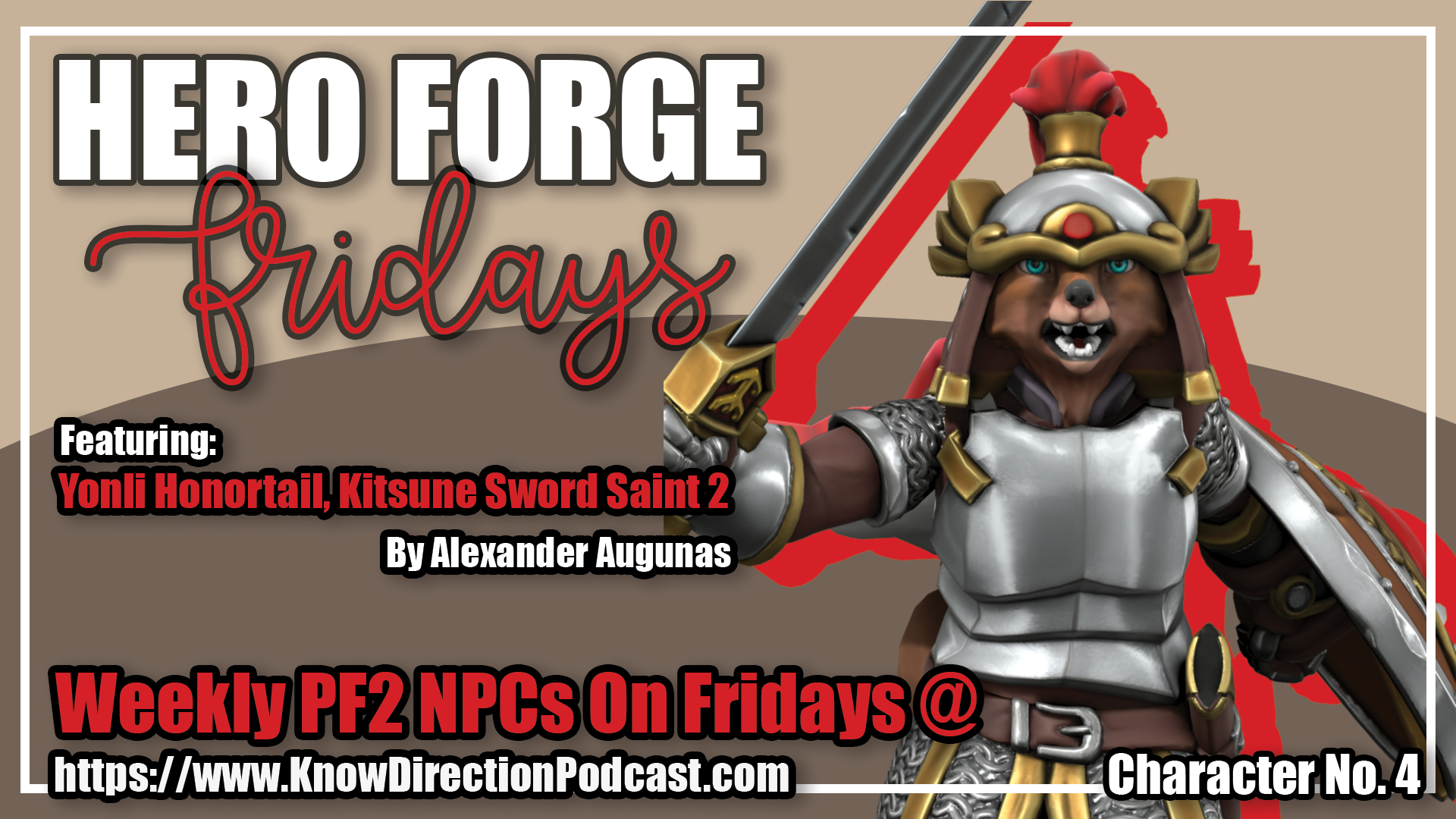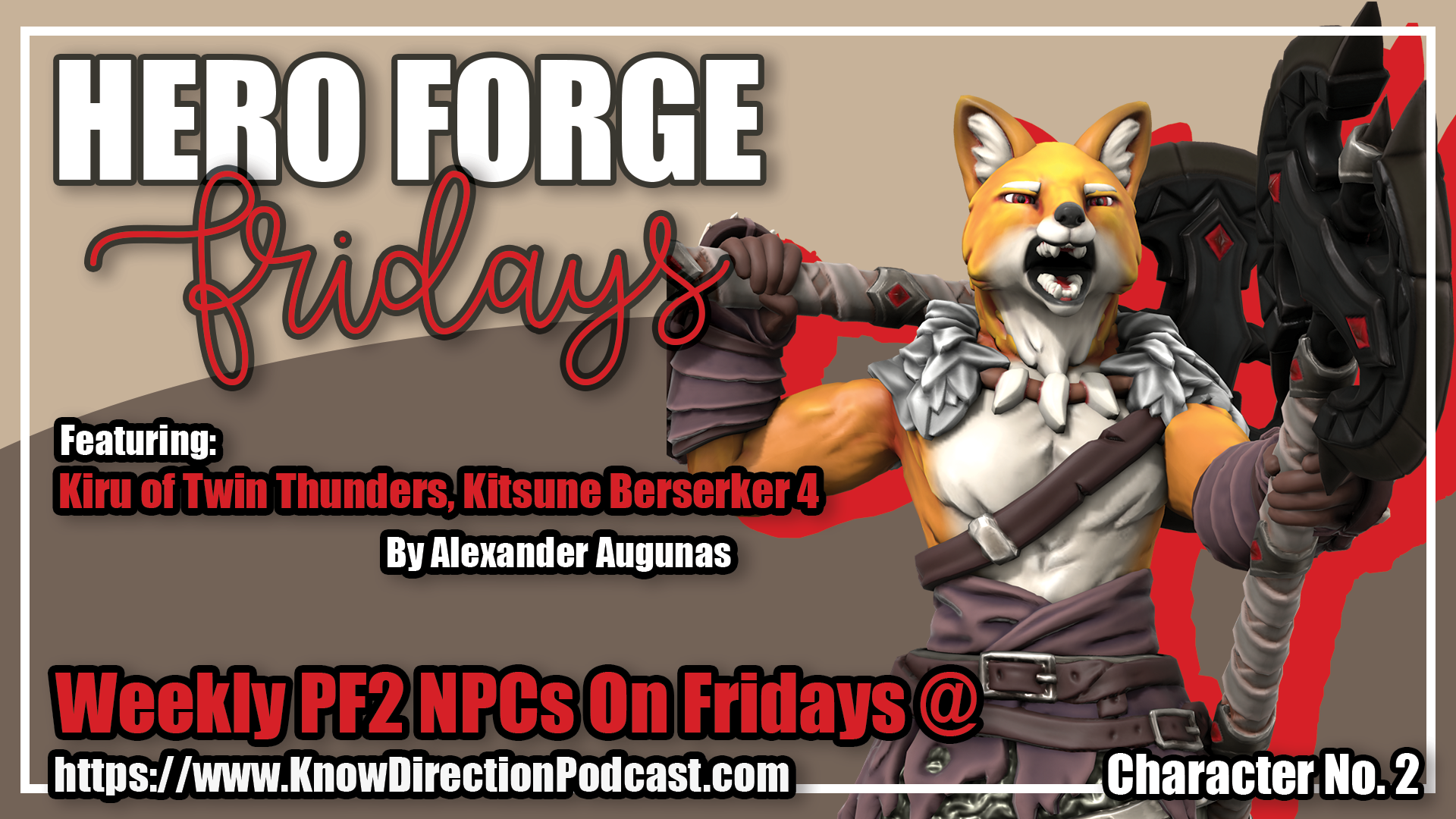Welcome to Guidance, Private Sanctuary’s source for tips and techniques for the Pathfinder Roleplaying Game, written by Everyman Gamer Alexander Augunas. Today, we’re going to be looking at a sanctified slayer build.
I think I mentioned it in the Oh, Those Carnival Nights build, but I actually used that particular Iconic Design as a PC. Let me tell you about it…
It was horrible. Absolutely horrible. The reason was due to something I didn’t count on: stuff trying to kill my familiar. Familiars are wicked squishy and as a result, I never wanted to send my little buddy into his certain death. I’m crossing my fingers that I’ll have a good reason to revisit that build when Paizo’s new Familiar Folio is released, but way back when I made the decision to tweak my build a bit so I didn’t need my familiar to fight with me. With my GM’s permission, I used all of my early tier mythic powers to transform him into a weapon.
Sadly, even that had unexpected consequences. Specifically on my bellflower tiller prestige class. Folks, let me tell you something: you cannot rely on your allies to help you activate any of your class features. This goes for teamwork feats, the scarecrow morale bonus, whatever. You see, the sad truth is that your allies will place their own abilities over yours unless they have some vested interest in working with you, such as actually investing a teamwork feat into using a strategy with you. But if you rely on solo tactics or benefits that your allies can’t reap, forget about getting their help. Ever.
So my character was trudging along slowly when all of a sudden, something amazing happened. The Advanced Class Guide was released. And within it, an archetype that would change my build forever.
Background
I gave you the quick rundown on my character, Yansu Hyomoto. He was a crazy multiclass character originally: fighter 1 / rogue 3 / inquisitor 3 / bellflower tiller 1. It was more than a little ridiculous. I went into this build mostly for the bellflower tiller’s scarecrow ability, which gave a scaling morale bonus to hit and damage enemies. However, we’re playing Wrath of the Righteous, so the favored community abilities were set to have little use in our games and I wasn’t looking forward to those levels. But then an archetype came out that made it so my rogue levels and bellflower tiller levels were completely unnecessary. That archetype is…
Build Concept
- Inquisitor (Sanctified Slayer): Oh man, I love this archetype. Trades judgment (which I almost never used as a multiclass inquisitor) for studied strike and sneak attack damage. As soon as I read this archetype, I almost immediately traded all of my rogue and prestige class levels for more inquisitor levels. I ended up loosing evasion and bellflower crop, but in the long run it was so totally worth it. Allow me to show you why.
Early Levels (1–7)
- Classes: Fighter (Lore Warden) 2 / Inquisitor (Sanctified Slayer) 5
- Feats: Power Attack (Bonus), Skill Focus: Knowledge (planes) (1st), Combat Expertise (Bonus), Improved Feint (Bonus), Eldritch Heritage: Arcane (3rd), Outflank (Bonus), Gang Up (5th), Menacing Bane (7th)
- Abilities: Bane 5/Day, Cunning Initiative, Detect Alignment, Discern Lies, Domain (Travel), Expertise, Monster Lore, Sneak Attack +1d6, Solo Tactics, Stern Gaze, Studied Target +2, Track
- 2nd-Level Inquisitor Spells: invisibility, knock, tactical acumen
- 1st-Level Inquisitor Spells: cure light wounds, divine favor, expeditious retreat, true strike
- Orisons: brand, create water, detect magic, guidance, read magic, sift
I needed to keep my fighter levels for several reasons. First, I needed proficiency with martial weapons, and who wants to spend a feat on those? Second, my character is feinting-focused, so getting a free bonus feat and free Combat Expertise at the same time is impossible to resist. From there on out, though, I went straight Inquisitor and grabbed a few awesome tricks.
First is studied target. In this stage of the game, it nets me a +2 bonus to hit and damage up to two targets of my choice. This is already better than what scarecrow could have given me. Furthermore, I have SPELLS! Honest-to-goodness SPELLS! Yansu’s domain is the Travel domain, so I tried to pick mostly A) kitsune-like trickery spells and B) travel-related magic. I also picked spells that helped allies because Yansu is big into communities.
One really neat trick that Yansu can pull off involves the Outflank feat. As you can see, Yansu has Outflank, Gang Up, and Menacing Bane. If two or more allies (not including himself) are flanking an enemy, Yansu gains his flanking bonus against the target no matter where he is positioned. Our party includes a mounted paladin, so all Yansu really needs to do is follow the paladin and he’ll be able to take advantage of how distracted his enemies are by the mounted guy. Furthermore, Outflank improves that bonus to +4 and if I use Menacing Bane to gain the menacing weapon propery, my flanking bonus further increases to +6. Including studied strike into the mix brings my final to-hit bonus to +8 between these feats and studied strike alone. Of course, meaning is only really useful if I have other allies in a flanking position as well. If my allies aren’t flanking (and therefore would receive no benefit from menacing) then bane is the superior choice.
Will it remain superior? Let’s see!
Mid Levels (8 –14)
- Classes: Fighter (Lore Warden) 2 / Inquisitor (Sanctified Slayer) 12
- Feats: Power Attack (Bonus), Skill Focus: Knowledge (planes) (1st), Combat Expertise (Bonus), Improved Feint (Bonus), Eldritch Heritage: Arcane (3rd), Outflank (Bonus), Gang Up (5th), Menacing Bane (7th), Precise Strike (Bonus), Vital Strike (9th), Swarm Strike (Bonus), Devastating Strike (11th), Team Up (13th), Escape Route (Bonus)
- Abilities: Bane 5/Day, Cunning Initiative, Detect Alignment, Discern Lies, Domain (Travel), Expertise, Greater Bane, Monster Lore, Slayer Talents (Trapfinding), Sneak Attack +3d6, Solo Tactics, Stalwart, Stern Gaze, Studied Target +2, Track
- 5th-Level Inquisitor Spells: divine pursuit, litany of vengeance, mass cure light wounds
- 4th-Level Inquisitor Spells: battlemind link, greater invisibility, freedom of movement, litany of escape
- 3rd-Level Inquisitor Spells: burst of speed, cure serious wounds, dimensional anchor, remove disease
- 2nd-Level Inquisitor Spells: invisibility, knock, litany of defense, perceive cues, tactical acumen, whispering wind
- 1st-Level Inquisitor Spells: comprehend languages, cure light wounds, divine favor, expeditious retreat, horn of pursuit, true strike
- Orisons: brand, create water, detect magic, guidance, read magic, sift
So we’re getting into a few of the weirder teamwork feats now. Swarm Strike is a neat little feat that gives me a bonus to hit and damage with an attack of opportunity per ally who A) has the feat and B) threatens the target. I’m likely to get a +1 or +2 out of this feat if I stick with my paladin buddy, which is handy. I also get Escape Route, which allows me to move through my allies threatened area without provoking attacks of opportunity from my enemies. This is a great teamwork feat for a travel-oriented character.
My spell list continues to reflect my themes of community, trickery, and travel for the most part. Some gems on the list are battlemind link, litany of escape, and divine pursuit. Divine pursuit is especially cool because it grants you a movement speed that is able to chase down your enemies. I’m also a big fan of dimensional anchor: not only can I travel, but I can stop heretics from travelling freely too.
At 9th level, you can see my build’s damage-based focus start to creep up: Vital Strike. This feat gets a really bad rep, but on a medium base attack bonus class, its not bad. Of course, it helps that I’m mythic and will be buffing this one attack action to crazy levels of insanity, as you’ll see in the mythic section of this article. Because I am focusing my attacking potential into one standard action, you can also see me picking up a few tricks to do with my move action. When I’m alone, I feint. When I’m ganging up on someone with Gang Up, I use team up. I can even choose to declare my studied target as a move action if I want. I also gain back trapfinding, thanks to my slayer talent. Waiting until 8th level (or 10th in my case) is harsh, but the slayer’s version of trapfinding is trapfinding and trap sense rolled into one. I never had trap sense in my previous build and I don’t care for the ability when its earned alone, but if its rolled up into another ability, sure. Give it to me!
Finally, I get greater bane, which doubles the damage caused by bane. (4d6 instead of 2d6). This is going to make it very difficult to justify giving my allies the Menacing ability, so if it turns out that I never use this feat, I might decide to retrain Menacing Bane for Extra Bane instead. But we’ll see. We’ll certainly see.
Endgame (15+)
- Classes: Fighter (Lore Warden) 2 / Inquisitor (Sanctified Slayer) 18
- Feats: Power Attack (Bonus), Skill Focus: Knowledge (planes) (1st), Combat Expertise (Bonus), Improved Feint (Bonus), Eldritch Heritage: Arcane (3rd), Outflank (Bonus), Gang Up (5th), Menacing Bane (7th), Precise Strike (Bonus), Vital Strike (9th), Swarm Strike (Bonus), Devastating Strike (11th), Team Up (13th), Escape Route (Bonus), Improved Vital Strike (15th), Coordinated Charge (Bonus), Seething Hatred: Demons (17th), Extreme Prejudice: Demons (19th), Ferocious Loyalty (Bonus)
- Abilities: Bane 5/Day, Cunning Initiative, Detect Alignment, Discern Lies, Domain (Travel), Expertise, Exploit Weakness, Greater Bane, Monster Lore, Slayer Talents (Trap Spotter, Trapfinding, Unwitting Ally), Sneak Attack +5d6, Solo Tactics, Stalwart, Stern Gaze, Studied Target +2, Track
- 6th-Level Inquisitor Spells: greater dispel magic, heal, legend lore
- 5th-Level Inquisitor Spells: divine pursuit, litany of vengeance, mass sure light wounds, true seeing
- 4th-Level Inquisitor Spells: battlemind link, greater invisibility, freedom of movement, litany of escape, sending
- 3rd-Level Inquisitor Spells: burst of speed, cure serious wounds, dimensional anchor, remove disease, speak with dead
- 2nd-Level Inquisitor Spells: invisibility, knock, litany of defense, perceive cues, tactical acumen, whispering wind
- 1st-Level Inquisitor Spells: comprehend languages, cure light wounds, divine favor, expeditious retreat, horn of pursuit, true strike
- Orisons: brand, create water, detect magic, guidance, read magic, sift
The only thing here that I feel the need to comment on is Seething Hatred and Extreme Prejudice. Seething Hatred doubles my studied target bonuses against one specific type of creature (I choose demons because I’m playing in Wrath of the Righteous) and Extreme Prejudice increases my sneak attack damage dice from d6s to d8s against my chosen type of enemy. Yeah, pretty crazy.
Mythic
Here’s a quick run-down of my mythic plan:
- Feats: Power Attack (1st), Vital Strike (3rd), Dual Path: Marshal (5th), Extra Mythic Power (7th), Extra Path Ability (9th)
- Path Dabbling: Transformative Familiar (1st), Legendary Item (2nd), Legendary Item (3rd), Divine Source (Chaos, Good) (4th), Perfect Aid (5th), Sneaking Precision (6th), Legendary Item (7th), Loyalty (8th), Divine Source (Travel; Friendship, Revelry) (9th), Longevity (Bonus), Divine Source (Community; Family, Cooperation) (10th)
First, to answer your question, yes. My GM gave me special permission to use Legendary Item on my transformative familiar. Whether or not you can is entirely up to your GM, but we both thought it would be really cool. (Especially since I destroyed an evil, intelligent glaive in order to do so). This will allow me to upgrade my item with both the usual intelligent item powers (at the usual gp cost) and the special ones allowed by the legendary item path ability. My bread and butter is the cheap 1st-level spell enlarge person, which my weapon will be able to cast on me, saving me an action. My Team Up feat really shines when I get the perfect aid ability, as it allows me to add my tier to the bonus I give out with aid another. That is fantastic. Furthermore, I want to be a god, so I grabbed some fitting Divine Sources. Having the full inquisitor spellcasting list means that I get to add all of the 6th level or lower spells from those domains to my list of inquisitor spells known. Here’s a quick rundown:
- Chaos: protection from law (1st), align weapon: chaos only (2nd), magic circle against law (3rd), chaos hammer (4th), dispel law (5th), animate objects (6th)
- Revelry: hideous laughter (2nd), good hope (6th), heroes’ feast (6th)
- Community: bless (1st), shield other (2nd), prayer (3rd), imbue with spell ability (4th), telepathic bond (5th), heroes’ feast (6th)
- Cooperation: borrow skill (1st), share language (2nd), coordinated effort (3rd)
- Family: calm emotions (2nd), create food and water (3rd)
- Good: protection from evil (1st), align weapon: good only (2nd), magic circle against evil (3rd), holy smite (4th), dispel evil (5th), blade barrier (6th)
- Friendship: shield other (2nd), telepathic bond (5th)
- Travel: longstrider (1st), locate object (2nd), fly (3rd), dimension door (4th), teleport (5th), find the path (6th)
There are some pretty great spells on that list!
The Strategy
Basically, my build is built around Vital Strike’s x2 weapon damage dice ability. I can’t ever grab Greater Vital Strike, but I do get up to Improved Vital Strike, plus Devastating Strike. Devastating Strike allows me to add +2 damage to my Vital Strike per additional set of weapon damage that I deal, so +2 with Vital Strike or +4 with Improved Vital Strike. Mythic Vital Strike will allow me to multiply all modifiers by the number of damage dice I deal with Vital Strike. Sneak attack isn’t multiplied, but everything else is. Finally, my Legendary Item will have the Foebitter ability starting at Tier 3, which allows me to spend a use of legendary/mythic power in order to double all damage done by the weapon. So, in effect, my build looks like this at 20th level:
- Target AC (CR 30): 48
- Buffs: Enlarge Person
- Attack Bonus: BAB 15 + 4 (Outflank) + 5 (Enhancement) + 2 (Bane) + 4 (Studied Strike) + 10 (Strength) – 1 (Size) = +39 (Hit on a 9 or better)
- Damage (Bardiche): 21 (1d10 increased to 2d6 by enlarge person, three sets of 2d6 Improved Vital Strike) + 204 (15 Strength + 14 (4d6 Bane) + 8 (Studied Strike, multiplied by x2 against demons) + 22 (5d8 sneak attack, increased to d8s against demons) + 3 (1d6 from Precise Strike) + 4 (Devastating Strike) = 68, multiplied by x3 from Mythic Vital Strike) = 225. When using foebitter, doubles to 450 damage.
- Chance of occurrence: 55%.
Remember that the above doesn’t include any of the buff spells that I could give myself, like divine power or divine favor. And that is why you can’t throw a single boss monster against a mythic party.
That’s my iconic design for the week! Hope you enjoyed it. Leave me any questions, comments, or ideas you have below and I’ll see you next Friday for another Iconic Design!
Alexander “Alex” Augunas has been playing roleplaying games since 2007, which isn’t nearly as long as 90% of his colleagues. Alexander is an active freelancer for the Pathfinder Roleplaying Game and is best known as the author of the Pact Magic Unbound series by Radiance House. Alex is the owner of Everyman Gaming, LLC and is often stylized as the Everyman Gamer in honor of Guidance’s original home. Alex’s favorite color is blue, his favorite Pathfinder Race/Class combination is kitsune sanctified slayer, and yes, he plans on smacking some demons for 450 damage. Bwuhahahahahahahahahahahahahahaahahahahahahaha!





Sadly, it also shows one of the inherent weaknesses of the Mythic System: Way too much damage output.
But… overall I think this is probably a superior build to the one before. That Outflank+Menacing combo is a nasty one, it’s a shame that it was pointed out to me archer Inquisitors can’t benefit from it with Snap Shot to stack Enfilading Fire on it as well 🙁 Adding Gang Up to your little combo is a brilliant idea though.
Thanks!
And yes, Mythic’s damage output is insanely high and survivability (both on the PC’s side and on the enemies’ side) isn’t high enough. After I finish Wrath of the Righteous (and hopefully get to those insane levels of damage outputs) I will be analyzing Mythic play in-depth in an article to hopefully give some ideas on how to smooth it out a little.
But its not worth talking about until I’ve experienced it first-hand. Gotta establish some creditability in that regard, first.
Tier 3 is where the damage really picks up with Mythic as that’s when Mythic combos start coming into play.
It may behoove you to keep some notes of what you’re capable of pre-Tier 3 and what happens after Tier 3. It’s been my experience that things snowball, and fast, once Tier 3 comes online.